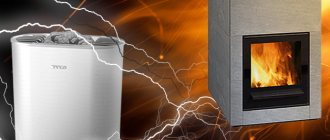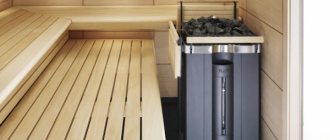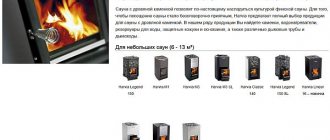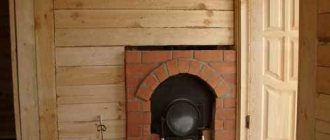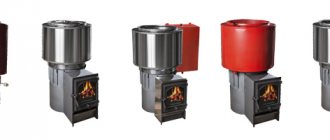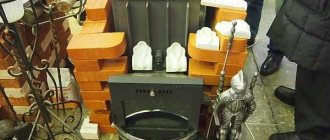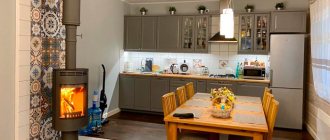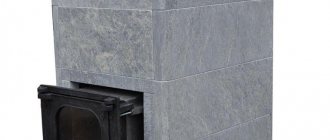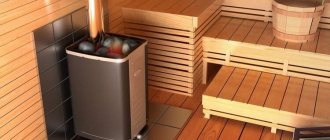Made of brick
A brick stove is a classic option for arranging a bathhouse. The quality of its work depends on the size, maximum heating temperature and the material from which it is made.
Brick stove
Advantages:
- the main advantage of a brick stove is the ability to retain heat for a long time after the heating has stopped;
- It protects the walls of a room better than metal ones from fire;
- creates high-quality steam;
- a high level of heat transfer allows for better heating of large areas;
- The brick walls of the heater do not allow combustion products to pass through.
Flaws:
- due to its large dimensions and weight, a solid foundation is required;
- The heating period for a brick stove is approximately 3 hours;
- large sizes take up a lot of free space in the bath;
- high cost due to the use of different types of materials.
Similarities and differences
When deciding which stove is better, the first thing you need to do is determine its functional tasks, because it will depend on them what is more suitable for the homeowner in each specific case.
All designs operating on solid fuel have a number of identical parameters:
- Both metal and brick products will have an open flame inside the firebox.
- At the moment when the structure body heats up, the room is filled with warm air and a comfortable temperature is created in the rooms.
- Products of fuel combustion are discharged through the chimney pipe.
- The chimney pipe must have the correct draft, otherwise the stove will not work properly.
- The combustion process is possible only if oxygen is supplied.
A metal and brick oven has a number of differences that are worth paying attention to. First of all, the difference lies in the material used to make the body of the heating device. In the first case, it can be cast iron or steel, and in the second - exclusively brick.
Nice cast iron stove
Many people wonder why iron stoves heat a room faster than brick stoves. The answer to this is quite simple and lies in the thickness of the housing walls: the smaller it is, the faster the structure warms up. Steel or metal can be very hot, while brick is an inert material and due to its greater thickness it does not heat up as much.
At the same time, if a metal stove gives off heat exclusively during the combustion of the flame inside it, then the stone structure maintains a comfortable temperature even after all the fuel has burned. This is done due to the ability of brick to accumulate heat and release it.
However, metal stoves have a significant advantage - their fireboxes have a clear system for regulating the fuel combustion process, which makes it possible not to overuse the material, and accordingly, the cost of maintaining the house during the heating season is reduced.
Good to know: How to prepare fireclay clay for laying a stove, how to mix the solution
A brick heating device has a significant mass, so it can only be erected after the foundation has been poured. Metal structures do not require this, which simplifies the installation process, and to save space, such a stove can even be hung on the wall.
Their gland
When choosing a brick or metal stove for a bath, preference is given to stone. But metal models today are no worse than their brick counterparts.
Stove example
Advantages:
- small dimensions, allowing you to independently assemble and install the structure;
- no need for a foundation or chimney;
- quickly warms up the room;
- using a small amount of firewood;
- affordable price.
Flaws:
- due to temperature changes, the body becomes deformed after a certain time and deteriorates due to corrosion;
- small range of models;
- relatively inexpensive price;
- cools down quickly;
- dries out the air, like in a sauna;
- Hot walls can cause injury or cause a fire.
Metal oven
The choice of such a stove is chosen by practical lovers of comfortable rest. A metal stove outperforms a brick stove in terms of installation time, room heating rate, and service life. It is quite easy to melt, which will make life easier for beginners in the bath business. It is important that with the right choice of furnace material, it will last for decades.
However, there are some drawbacks here too:
- A metal stove looks inferior to a brick stove because it looks unconventional. In this regard, if the interior and comfort of a bathhouse are extremely important to you, we advise you to think in advance about the finishing of a metal stove, visually bringing it closer to a brick one.
- When using low-quality material, a metal stove loses all its advantages. Therefore, if you have chosen just such a stove, make sure of the quality and authenticity of the material and do not try to save money on it. A real stove should be made of sheet steel or cast iron. Most manufacturers of sauna stoves have models with stainless steel fireboxes. Stainless steel has the main advantage - it will never burn out. Such a stove will not have to be repaired or replaced in 10-20 years.
As we can see, the stove is the heart of the sauna; the quality of the entire sauna process directly depends on it. To make the right choice, you need to take into account your time, material resources, practical skills and aesthetic preferences.
Conclusion
Everyone makes the decision to choose a stove for a brick or iron bath independently. It is clear that metal construction is cheaper . It takes up little space and can be installed independently. But for those who want to experience all the delights of a real Russian bathhouse , it is advisable to choose a brick stove. It is quite good, allows you to steam without having to monitor the temperature, and is also healthier than iron.
If you were able to make a decision, then take a stainless steel metal stove, it is inexpensive and practical.
Features of installing iron and brick stoves in baths
A stove in a bathhouse made of any material must be installed before finishing work begins.
Installation or laying of a stove involves construction work, after which debris accumulates, the air becomes dusty, concrete mortar is used for laying bricks, which can get on the walls, ceiling or shelves. To install a brick stove you will need more space than a metal stove, and its exhaust system is much larger. The fact is that for high-quality and fast heating of the brick, hot air must pass through several so-called wells built into the body of the furnace, and not immediately enter the street. For a metal one, you only need a hole in the wall or ceiling of the bathhouse, where the exhaust pipe will be led out. But for the iron version you will need a “cushion” made of fire-resistant material, which will protect the walls and floor from heating and eliminate the risk of fire.
Solution
The masonry mortar can be prepared in one of the following types:
- From cement mixed with fireclay clay,
- Made from cement mixed with porcelain tile adhesive,
- Made of clay and sand.
Old masters prefer clay mortar. There are a great many types of clay in nature. Each of them has its own properties, so the proportions of the composition will be different in each case. If there is too much clay, the dried composition will crack, and if there is too little, it will not set well. For the sample, you can prepare a solution in which sand and clay are almost equal and dry it. The results of this experiment will indicate what changes need to be made.
INTERESTING! Modern technologies make it possible to use the simplest solution - a ready-made “kiln mixture” prepared on the basis of red clay.
For good wood burning you need:
-dry firewood (2-3 years of drying under a canopy) (standard: 6-7cm log thickness,
length of logs (written: up to 75-80 cm) (Now I meet my local standard everywhere: default is 50 cm)
— the space above the fuel layer
is equal to or greater than
the height of the fuel layer
-high temperature (for evaporation of volatile combustible substances from the fuel and their combustion reaction)
-combustion also requires sufficient air (excess air dries out, and if there is not enough air, it smokes and clogs the channels)
— TIME: According to Podgorodnikov, 1-2 seconds so that all combustion processes take place in a hot firebox, and are not quickly thrown into the first cold channel or pipe.
That's why he always set hilo.
Firebox length
— along the length of the firewood + (7-10 cm.)
Firebox width
— for small furnaces (according to power) 1 brick = 25 cm.
In many ovens, 32 cm (brick + 1/4 brick) (considered appropriate).
Usually 1.5 kirp. (37cm) - enough for almost all occasions.
Powerful stoves for individual use have a firebox width of 2 bricks. (50 cm).
Correct masonry
The mixing of the mortar and the laying itself are carried out similarly to the case of lining a metal firebox. Here, for greater strength and accuracy of the structure, you can use metal corners and so-called “studs” with a diameter of 16 mm. With their help, both the internal frame and the entire external finish are formed.
ADVICE! When the width of the masonry is no more than 1 m, to create perfectly even seams, you can use iron rods with a square cross-section (pre-lubricated with machine oil), on top of which the mortar and a new row are placed. Then the rods are carefully pulled out without further settling of the laid row.
When installing the pipe, you should not forget that the distance from it to the elements of the rafter system of the house should be at least 15 cm.
for normal combustion:
from
grate to the hob: from 4 to 6 rows, I even saw 7 rows of bricks.
35-50 cm for hobs ,
60-70 cm for sauna heaters,
up to 80 cm for sauna fireboxes with a coil
According to Podgorodnikov: - from 80-90cm. up to 1m. for heating stoves.
Special and most important:
remember: above I wrote: “the space above the fuel layer is equal to or greater than the height of the fuel layer”
Therefore: fill a firebox of any height with wood only halfway
height, leaving space above the firewood for the combustion of gases released from the logs at high temperatures! It is not the wood itself that burns, but the gases that are released! There is no space or air - we get soot. And the smoking when opening the furnace door is for sure.
1. Everywhere in all the pictures there is space above the layer of firewood for the combustion of gases, we see it as a flame, equal in height to or slightly larger than the layer of firewood (we draw it correctly, but when we start installing (building) the stove, we completely “forget” “or because of saving material or “such a trifle is not worthy of attention.”
2. And the second interesting pattern: the grill for the heater DOES NOT LIE on the furnace door.
Conclusion: be sure to leave a distance between the top of the fire door and the stove grate (hob ( for the future) ) equal to the height of the fuel layer.
Don’t want to leave it? - make an excellent high pipe and very little resistance to flue gases in the stove, especially
during kindling).
I focus this way: I add the same amount to the height of the firebox door: - this is the height of the firebox. Another reason why the firebox door is at the bottom and is not huge in size and not even narrow-high, but small, low-wide: - it is impossible to fill the firebox to the top with firewood (this is done so that a person who does not know about this does not suffer). In any single-layer (12 cm) brick oven, cracks and cracks will appear (like a spider web of cracks). Even with very gentle ones (small amount of firewood in the stack), and with overflow. It's only a matter of time. Therefore, the firebox core (core) is made of refractory fireclay SHA-5 brick. Pay attention to the weight of the fireclay brick. With a 5mm gap around, they line the sauna stove with red brick. Kiln brick and building brick: these are completely different things! A stove in a stove or a stove in a case is obtained. If you are installing a core made of used fireclay bricks, pay attention to the weight of the brick. If it is lighter than red brick - alarm! - it is a thermal insulation brick. The inside of the firebox will be great, but the outside of the firebox wall will be forever cold. If it is much heavier than red, the outer surface of the firebox will be hot, much higher than the permissible standards, you can get burned, but if you have a case, it will be fine. Article about fireclay bricks: https://profcad.ru/profblog/?p=460
